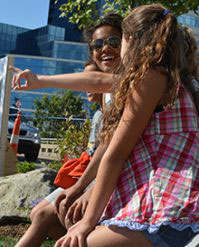On the Bridge Street Bridge — with traffic roaring by and glass giants towering nearby – Grand Rapids Public Museum School students Sophia Almonte and Delson Carson painted pleasing waves of blue and white across four lanes of traffic. The painted crosswalk symbolically connected the riverwalk across the speedway of cars and trucks — a dangerous, path-blocking barrier to river-walkers.
Students from the Museum School’s Urban Ecology class were part of a coordinated community effort to reduce such barriers, reconnect pedestrians to the Grand River and citizens to its historic role in the city’s development.

“There’s a lot of history there,” Sophia said, as she and other students engaged visitors during the commotion of ArtPrize. “And we’re sharing that history with everyone that we see.”
She and other students surveyed bridge visitors while teaching them about the history of the Grand River, as part of an ambitious project called “River for All.” The Museum School eighth-graders joined with city officials, landscape architects, nonprofits and universities in a design experiment to reimagine the 7.5-mile Grand River corridor.
The public-private partnership brought together civic visionaries with a school that specializes in “placed-based learning,” using the city as a living classroom.
“The whole project was centered on community partnerships and students doing authentic work,” said science teacher Nate Langal. “I’m glad to be a part of a district where that is happening more and more all over the city.”

Raising River Awareness
Students played important roles in the far-reaching project, overseen by Williams & Works, an engineering, surveying and community planning firm. River for All aims to increase access to the river and fill missing segments along the Grand River trail, from Riverside Park down to the former Butterworth Landfill, said Lynee Wells, principal and urban planner with Williams & Works.
“We envision trail connections that are carefully thought out, accentuate the beauty of the environment, inspire a physical connection and to draw us here,” Wells said. “Our goal is to have new buildings engage with the river instead of turning their backs on it.”
Officials hope the project will not only enhance the river walk but the public’s understanding of the Grand River’s role in the city’s history, from the time it was settled by Native Americans through its vital role in the logging and furniture industries.
“In modern industrial times, we have largely seen it as a nuisance or a barrier – something in the way,” said the city Traffic Safety manager Chris Zull. “We’ve now come to recognize that it is a beautiful part of our city, and we’re looking for ways to make the river atmosphere a part of our culture on many levels.”

Relishing the Great Outdoors
To that end, Williams & Works closed an eastbound lane of traffic on the bridge, where Viridis Design Group assembled a pop-up green micro-habitat of plants native to Michigan’s riverbeds with picturesque names: phantom joe-pye, October skies aromatic aster, Karl Foerster’s feather reed grass. The plants intermingled with walkways, scattered rock-boulder piles for sitting and a long skinny table with tall chairs.
Looking to connect with the river in a very tangible way, the Museum School had its Urban Ecology class create a survey to collect community input for the future of the river while valuing its past.
Langal’s students collected photos of artifacts at the Grand Rapids Public Museum, wrote timeline summaries, and edited it all into a photobook that was printed at Grand Valley State University. They also promoted the event and borrowed teaching tools from Groundswell and the West Michigan Environmental Action Council, Langal said.
‘We’re a big part of ecology. We can do things to kill ecology or we can do things to make it better.’ — Museum School student Olivia Lavengood

With stencils and spray paints in hand, students Nick McClellan, Vito Crittenden, Olivia Lavengood and Haley Miller fanned out along the bridge to lead ArtPrize pedestrians to a hands-on activity studio.
The students marveled at their good luck to be outside, breathe the fresh air, let the sun warm their faces, touch the water’s edge and enjoy the moment of freedom near a wild place tucked into concrete jungle. As they gathered, a blue heron flew under the bridge, scattering seagulls and pigeons in its wake.

“That is so cool,” Olivia Lavengood said. “We’re a big part of ecology. We can do things to kill ecology or we can do things to make it better.”
Haley Miller added: “We are living organisms that need things like plants, trees and not so many cars. So maybe we should plant a city for humans.”
Students created displays such as a baby pool filled with river water and baby ducks, and “enviro-scape” flowing with soy sauce and oil, signifying the runoff that pollutes the water.
“I’m happy to be part of something this big,” Haley said.
CONNECT











